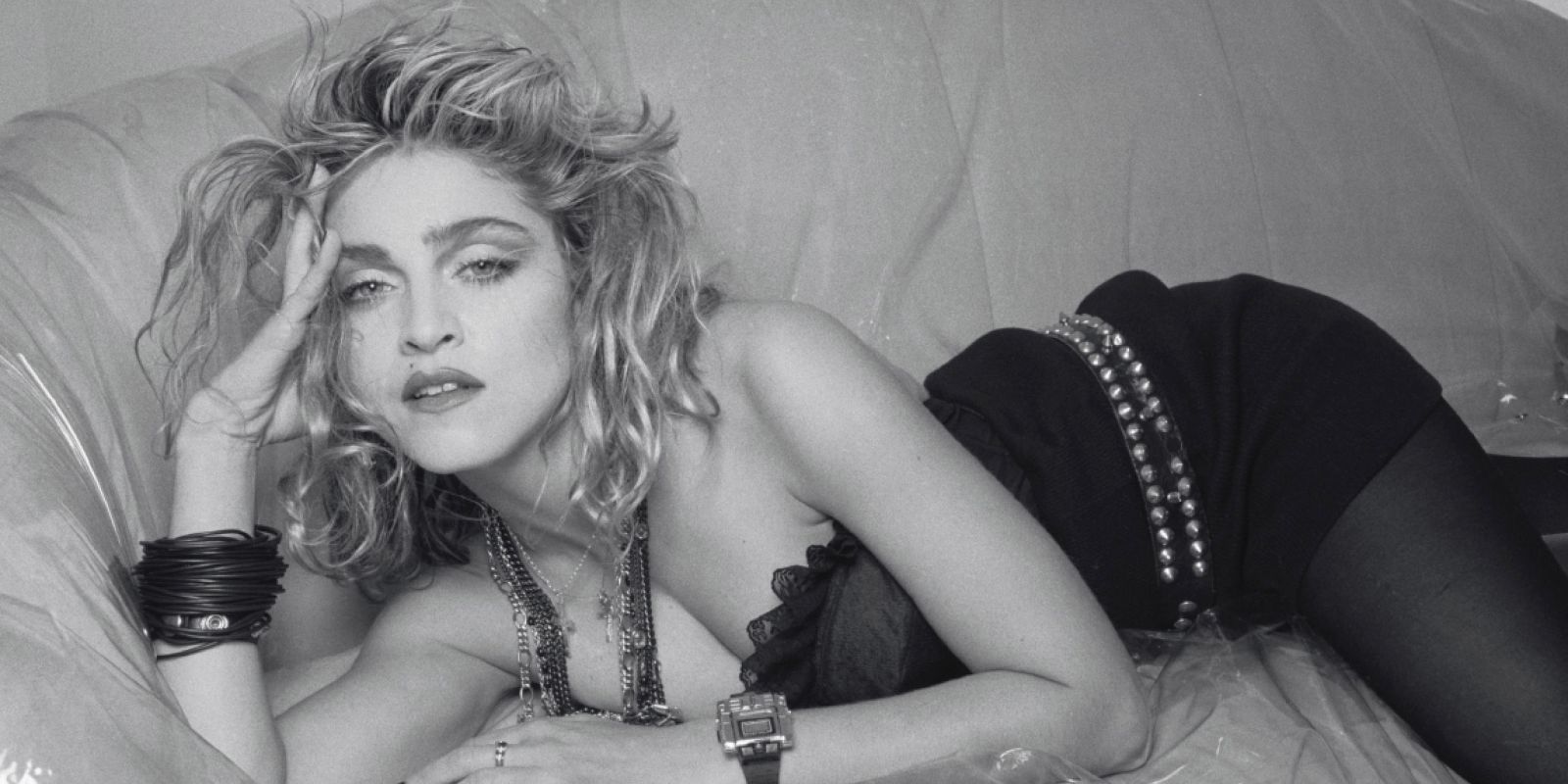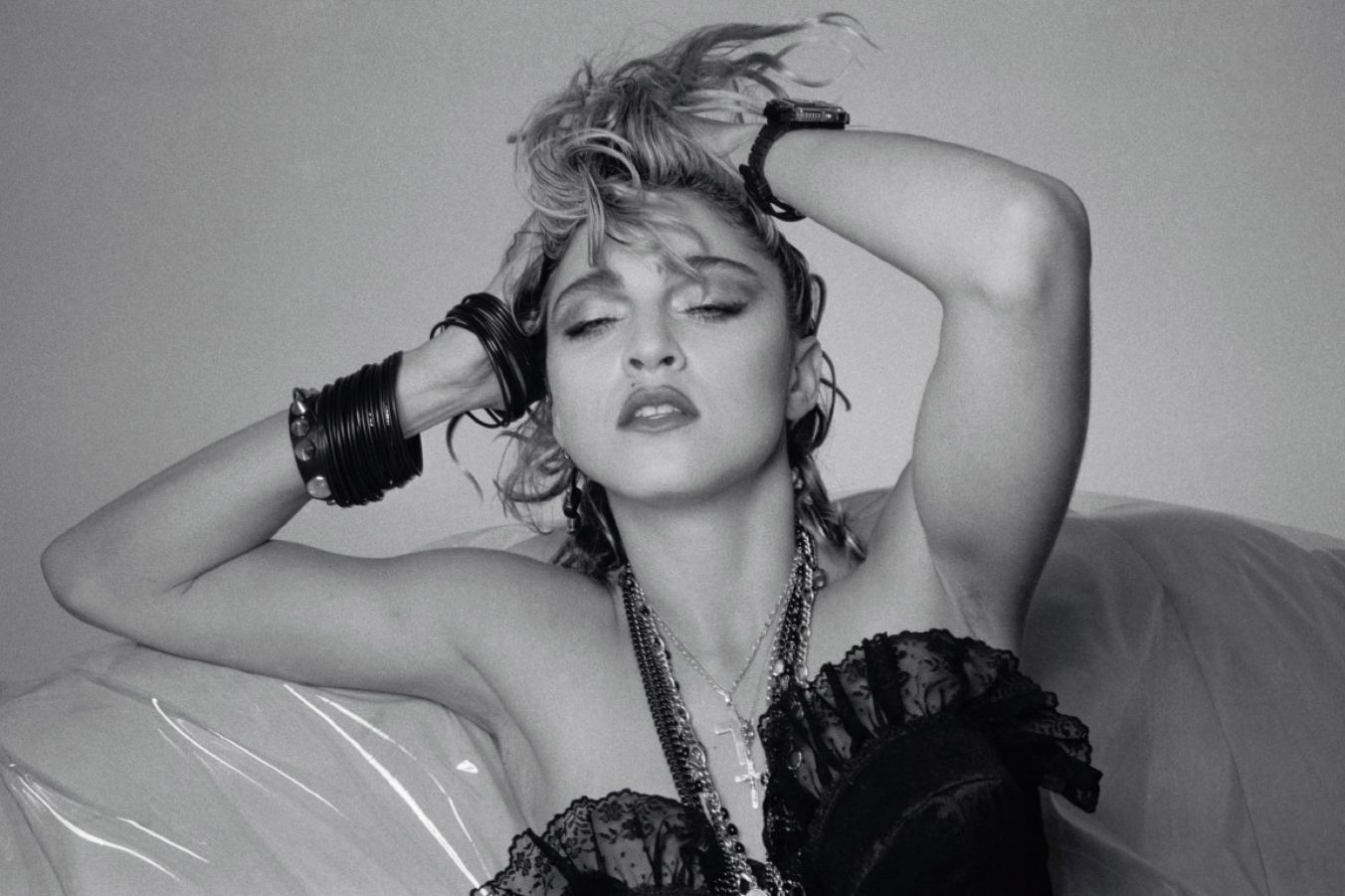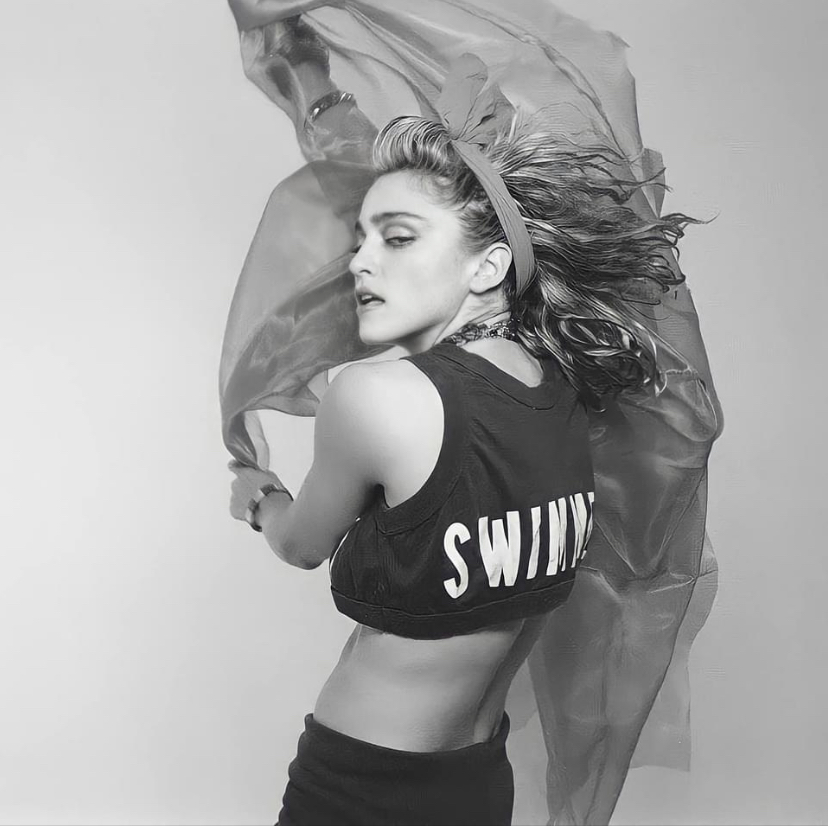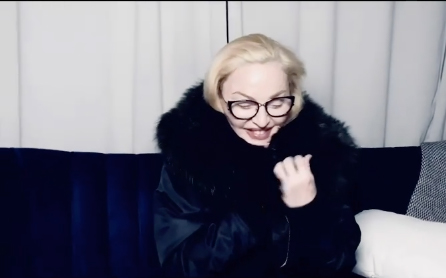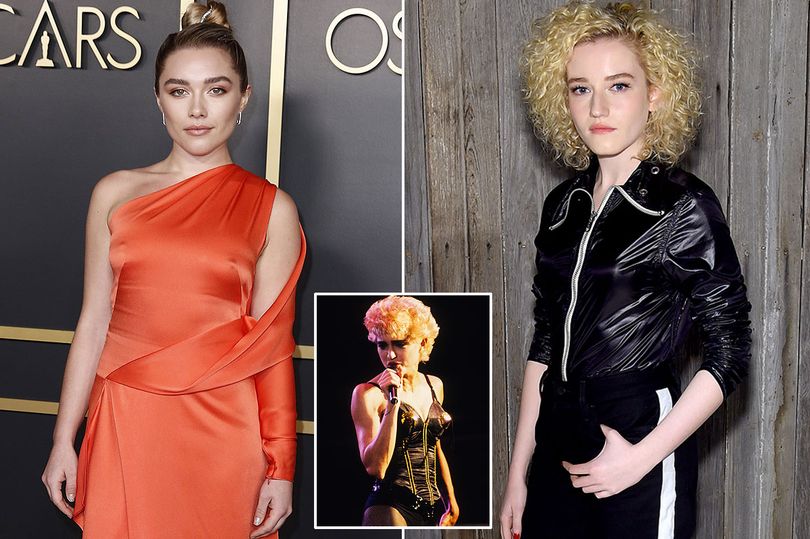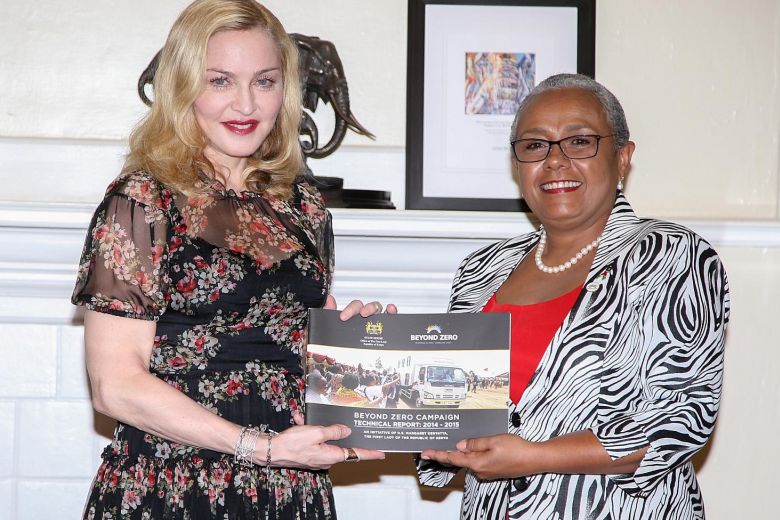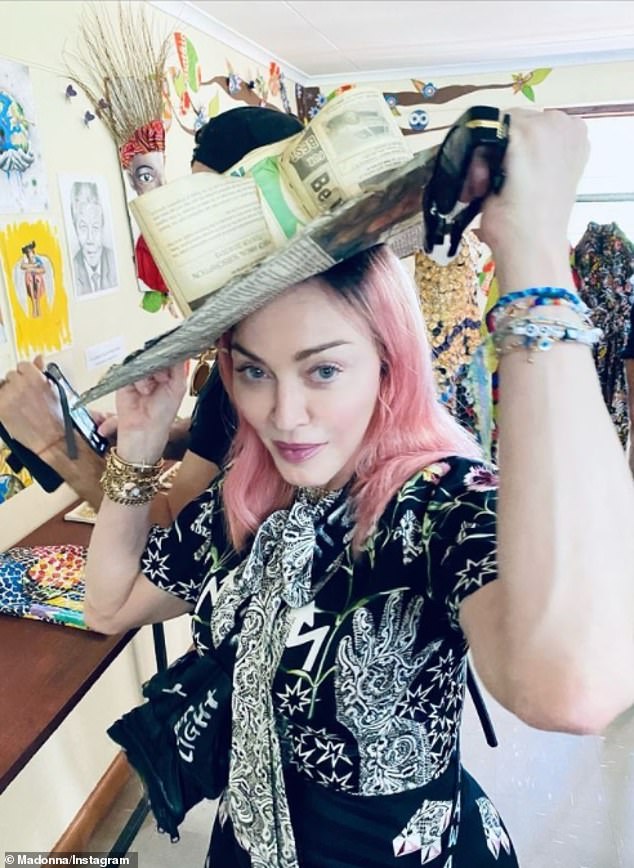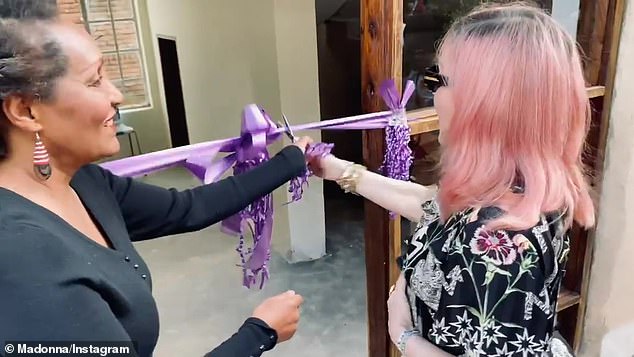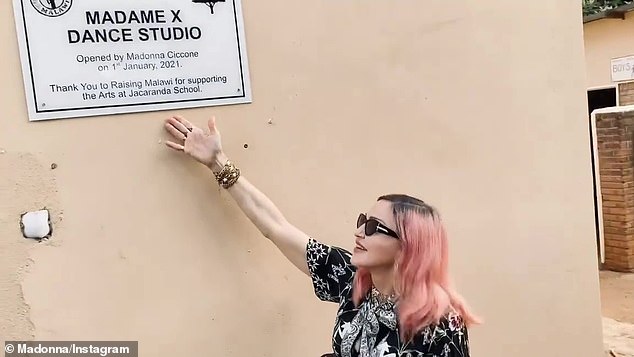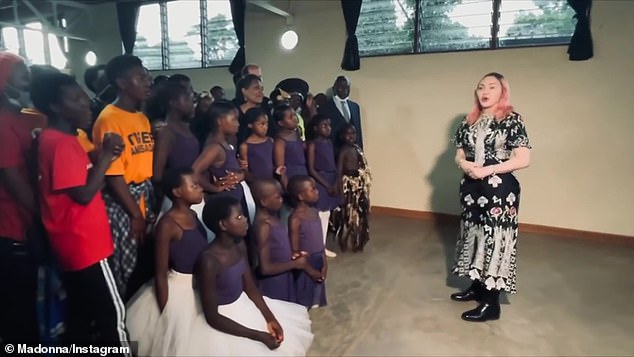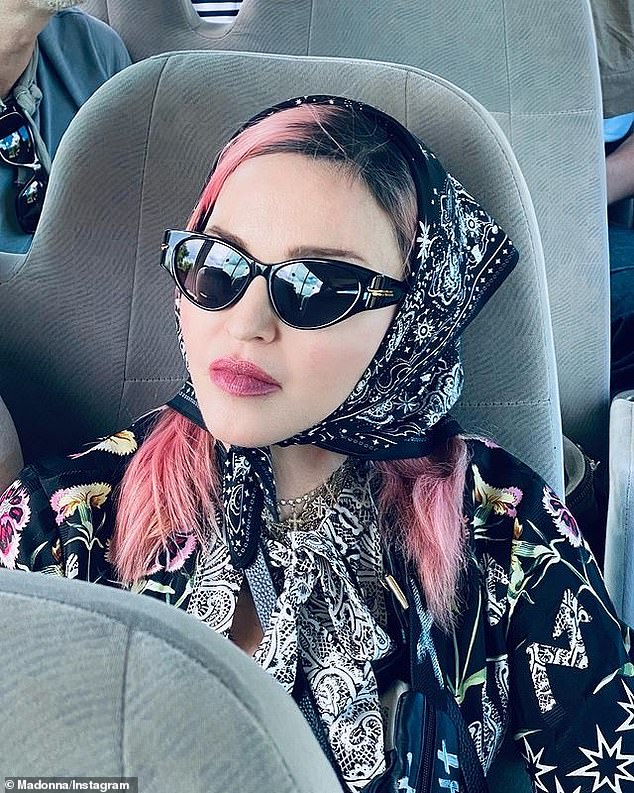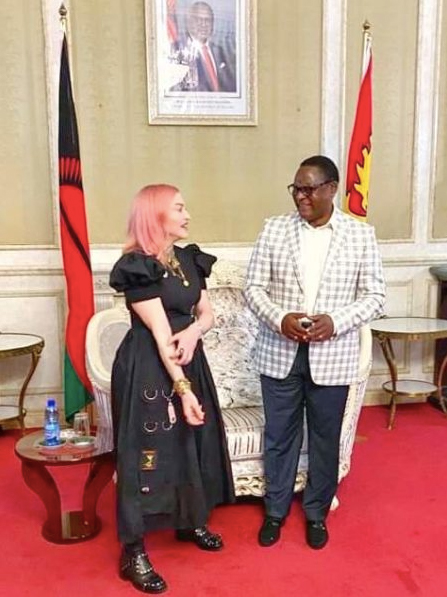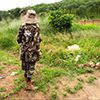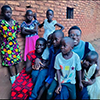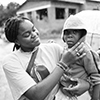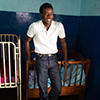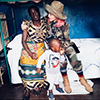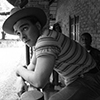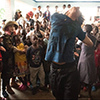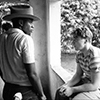| |
Madonna news - Jan. 2021
← Dec. 2020 | Feb. 2021 →
Rare 1985 photos now available in art book
Source: W Magazine - 26 January 2021In 1985, Madonna made her first-ever trip to Japan. She'd just released Like a Virgin, the follow-up album to her self-titled debut, with Nile Rodgers as a co-producer, and traveled to Tokyo to promote the record.
For most fans of Madonna, this is likely the pop icon's most identifiable era, especially visually speaking: teased hair, wedding dresses with fingerless gloves, references to Jean Paul Gaultier and Vivienne Westwood, the "Boy Toy" belt. And it was during this watershed moment that Playboy magazine tapped the photographer Kenji Wakasugi to shoot her.
The Osaka native was allotted 45 minutes with Madonna in a spare studio space, where he set up a pink couch covered in plastic and a flash unit—that was all in terms of props and equipment.
There were no stylists, nor a glam team; Madonna came to the shoot wearing her own clothing (a bustier, Takara Kronoform robot watch, Maripol's layered rubber and crucifix jewelry). As Wakasugi recalled, her energy and vibrant spirit did more than enough to fill the room.
"Madonna was very modest, had a great manner, and seemed powerful," the photographer said. "I adored her smile."
The contents of that promotional shoot, considered relatively bare bones at the time, are now enshrined in a limited-edition book named Adore, published by NJG. Adore not only contains never-before-seen outtakes from the photoshoot with Madonna, but it's also bookended by more pictures Wakasugi took during the 1980s: images of neon street lights, floral motifs, and commuters darting through the streets of Tokyo evoke the mood of that time, and speak to the photographer's tendency to capture culture meeting nature.
One look at Wakasugi's website—which is chock full of outdoor photography much more akin to Ansel Adams's style than Steven Meisel's—and you wouldn't be blamed for expressing surprise that a guy like him was commissioned for a Madonna shoot.
But the Tokyo Technical School of Photography graduate has also lensed the likes of Glenn Close, Richard Gere, and Hall & Oates over the course of his career.
His soft-focus touch and tendency to capture people in their most natural state comes through in the Madonna photographs.
On set, Wakasugi recalled that he wasn't able to communicate with the star further than a few words of encouragement, but her "vigorous" personality told him everything he needed to know. She was more than comfortable in front of the camera.
Detox says Ray Of Light album freed her of suicidal feelings: 'my saving grace'
Source: Attitude - 23 January 2021Detox has said Madonna's seminal album Ray of Light helped save her from suicidal feelings upon its release in 1998.
Madge's critically-acclaimed seventh album contains hits like 'Frozen', 'Nothing Really Matters' and the title track of the same name.
Drag icon Detox, who shot to fame on the fifth season of RuPaul's Drag Race, was just 12 years old when the LP came out.
Speaking on The Things That Made Me Queer, the new podcast from RPDR UK's Crystal, the All Stars runner up said: "When I talk about Ray of Light, I contribute it to saving my life.
"It came out in 1998, I was 12 years old, just moved from Arizona to North Carolina... it was the first time I had experienced people being really bigoted, and racist, and being shamed for being a young closeted queer boy being called a faggot, being ridiculed not only by students but teachers, and adults for being effeminate.
"At 12 years old, I was very depressed, very suicidal, not in a good headspace. When this album came out I immersed myself in it, it was my saving grace."
Detox, whose own songs include 'Chow Down' and 'I Like It Like That', continued:
"I had a little nook in the house we were renting, with a little seat in the window and I remember putting all my pillows in the window - I'm going to cry - and sitting there for hours with that album on repeat thinking of a life beyond that.
"It was an ethereal vacation from that difficult time."
Madonna returns to editing her Madame X tour recording
Source: Instagram - 20 January 2021Returning from her holidays in Malawi and Kenya, Madonna has dyed her hair blond again, and announced on Instagram that she's continuing the editing process of her Madame X Tour recording.
While her headline mentions 'coming soon', a specific release date is not yet known.
Maluma talks working with Madonna in 'Elle' cover story
Source: ET Canada - 16 January 2021Maluma's music is becoming successful on a global scale, which has put him on the cover of the February issue of Elle.
The Colombian singer will make the jump from music to movies, co-starring with Jennifer Lopez and Owen Wilson in the upcoming rom-com Marry Me.
Maluma also discussed "Medellín", his steamy collaboration with Madonna, and performing the song live with her at the 2019 Billboard Music Awards.
"Madonna loves doing things in an organic way — she is very spiritual," Maluma said. "When we were doing the 'Medellín' video, it was almost 48 hours working nonstop, and I was surprised, because Madonna, she was 60 years old, but she looks like she is younger than me."
That admiration is a two-way street.
"When I first met Maluma, I was drawn to his positivity and good energy," Madonna told the magazine. "But when I got to know him, what surprised me was his work ethic. Being in the studio with him was effortless, and performing with him on 'Medellín' was a gratifying collaboration. We proved to be creative kindred spirits and had a fun time doing it."
In fact, Maluma believes the connection he forges with artists such as Lopez and Madonna is more spiritual than anything else.
"I feel like the artists right now, the modern artists, are losing their spirituality, and that's kind of sad," he said. "I don't feel like they pray or meditate, and that's why I feel connected with artists like Madonna, Shakira, and Jennifer. Sometimes people tell me that I'm an old soul because of that, but at the end of the day, you can be the biggest star in the world, but if you are not spiritual, you are empty inside."
The entire interview is featured in the latest issue of Elle.
Madonna wants 'perfect' star to play her in biopic - and it could be Brit Florence Pugh
Source: The Mirror - 10 January 2021Queen of pop Madonna is Desperately Seeking the "perfect" actress to play her on screen… and English actress Florence Pugh could be the one.
The Little Women actress, 25, is said to be neck and neck with Ozark's Julia Garner, 26, in the race to win the role.
Madonna, 62, is co-writing the much-anticipated biopic and will also direct it. And as for the leading role, fans can't wait for her to decide Who's That Girl.
An insider told the Sunday Mirror: "Realistically, there are only a couple of people in town who could pull this role off.
"The bosses who are helping put the movie together want Florence and nobody doubts that she could be amazing.
"On the other hand, fans and the press have already weighed in and, from that perspective, Julia is their frontrunner because she is such a dead ringer for early-career Madonna.
"Still, there are serious politics and scheduling issues in the way of Julia landing the part.
"The final decision will be Madonna's alone, since she's directing and it's her story.
"She's really only got one shot to get this right. Like with Elton John's Rocketman, there isn't room for error. She's putting herself under serious pressure to find the perfect person."
Madonna is penning the script with Oscar-winning screenwriter Diablo Cody.
Julia was touted for the lead role after her Emmy-winning success in Netflix crime drama Ozark. She also starred in movie The Assistant.
But Madonna also connected with Oscar nominee Florence after fans pointed out the resemblance between her and the pop queen when she was young.
Speaking about the biopic, Madonna has said: "I want to convey the incredible journey that life has taken me on as an artist, a musician, a dancer… a human being trying to make her way in this world. The focus of this film will always be music.
"Music has kept me going and art has kept me alive."
"There are so many untold and inspiring stories and who better to tell it than me. It's essential to share the rollercoaster ride of my life with my voice and vision."
Madonna moved to tears on Kenya trip
Source: Straits Times - 10 January 2021Pop star Madonna was reduced to tears during a trip to Kenya as she listened to a man describe how his five-year-old daughter was recently raped by a neighbour in Nairobi's Kibera slum.
The 57-year-old singer met the man during a visit to Kibera last Saturday and Sunday. She was there to see how she could improve the lives of its residents, a spokesman said.
"This was an incredibly powerful and disturbing conversation about the realities of violence in these people's lives," said Mr Trevor Neilson, who manages Madonna's Raising Malawi and Ray Of Light foundations and accompanied her on the trip.
"These stories brought Madonna to tears," Mr Neilson told the Thomson Reuters Foundation.
Madonna, who took her four children to the East African country, posted a video on Instagram, showing them cleaning streets, clearing gutters and painting murals.
She also met Kenya's First Lady Margaret Kenyatta on Monday to discuss working with her charity to scale up maternal and child health programmes and initiatives against gender violence.
Madonna's welcome in Kenya was in contrast to the criticism she faced after visiting Malawi in 2013, when she was accused by the country of expecting its government to be forever chained in an "obligation of gratitude" towards her for adopting two Malawian children and contributing to the construction of classrooms there.
Watch Madonna's Super Bowl performance on her Youtube channel
Source: Youtube - 9 January 2021It took them almost 9 years, but Madonna's team has finally added a high quality video of Madonna's performance at the 2012 Super Bowl Halftime Show to her Youtube channel.
During her performance, which kicked off the promotion for the MDNA album at the time, Madonna performed Vogue, Music (featuring LMFAO), Give Me All Your Luvin' (featuring Nicki Minaj and M.I.A.), and Like A Prayer (featuring CeeLo Green).
Listen to Kelly Clarkson's cover of Borderline
Source: Inquisitr - 9 January 2021Kelly Clarkson dedicated her cover of one of Madonna's first hits — Borderline — to her musical director Jason Halbert for her latest performance on "Kellyoke," a popular segment on her daytime talk series.
In a clip posted to Twitter, as seen below, Kelly looked lovely in a brown dress. The garment had sleeves rolled up to her elbows. The dress fell to her knees and with it, she wore knee-high boots. The dress had a small collar and was open at the neck. A large belt cinched in the waist.
Kelly clutched the microphone stand. Several rings were seen on the fingers of both her hands as she sang the song made famous by the Material Girl off her debut album, Madonna.
~ Compare it our favourite rendition that Madonna brought on the Tonight Show Starring Jimmy Fallon on June 9, 2016.
Madonna visits Jacaranda School for Orphans, opens Madame X Dance Studio
Source: Daily Mail - 9 January 2021Seven-time Grammy winner Madonna capped off her 'amazing week in Malawi' with her four youngest children by visiting the Jacaranda School for Orphans near Blantyre last Friday.
The 62-year-old Queen of Pop was officially at the school to cut the ribbon at the grand opening of the Madame X Dance Studio.
Madge (last name Ciccone) proudly posed beside the sign at the studio, which was paid for through the non-profit organization, Raising Malawi, she co-founded with Michael Berg in 2006.
I feel like we ended on a very special note because Jacaranda is a very special place, as you know. The reason it's so special to me - not only because there's so many amazing, talented children here - but there's also amazing teachers and the founders are so passionate about what you do. It's contagious,' the longtime AIDS activist said in a speech to the school.
'You're teaching them skills that when it comes to art and creativity and expression - these are the things that keep us alive and keep us going through times of trouble and challenges. And you know, this has been a really tough year for everybody. But if you think about it, every year's a tough year in Malawi, right?
'So what's going to keep us going is loving what we do and it's great that you've created a place where children can come and continue to learn and love what they do and learn skills from visual arts, to designing clothes, to playing musical instruments, to dance - which is my first love. So this place really holds a special place in my heart. Just keep up the good work everybody and that's it. Believe in your dreams!'
While there, Madonna's 15-year-old son David Banda played guitar as the music class sang Bill Withers' 1972 hit Lean on Me.
The Levitating songstress belted the classic as her 14-year-old daughter Mercy James played along on an electronic keyboard.
And Madonna's eight-year-old twin daughters Stella & Estere - wearing matching black cargo jeans - strummed ukuleles.
The self-made superstar also brought along her back-up dancer-turned-toyboy Ahlamalik Williams who, at 26, is 36 years younger than her.
Days earlier, Madonna made visits to Mercy James Centre of Paediatric Surgery and Intensive Care as well as the village of Lipunga where David reconnected with his father Yohane.
'My interest is in the child's best chance for health and education,' Yohane explained to The Guardian back in 2006.
'It was a hard choice to make, but when it seemed likely that David would have a better life with a new family, I could not say no.'
Madonna visits Mercy James Pediatric Hospital
Source: Business World - 4 January 2021American singer and songwriter Madonna who is enjoying her homecoming trip to Malawi in Africa visited the Mercy James Institute for Pediatric Surgery and Intensive Care on Sunday and spent time with the children there.
The 'Queen of Pop' took to her Instagram on Sunday and shared a video of her visit to the Mercy James Pediatric Hospital.
In the caption for the video, she wrote
"Visiting Mercy James Pediatric Hosptial...........3 Years in and going strong. ! Thanks to Dr. Borgstein and the incredible team of health care workers that make it possible to save childrens lives everyday! Thank you folks around the world that continue to support @raisingmalawi #comealive #mercyjamescenter."
Malawi president Chakwera meets Madonna, praises her charity
Source: Nyasa Times - 2 January 2021Malawian President Lazarus Chakwera on New Year’s Day met with visiting U.S. pop singer Madonna, praising her efforts to help children’s education in the South African country.
Chakwera received the pop icon at the Kamuzu Presidential Palace in the capital, Lilongwe, where Madonna briefed him about her charity work in the country.
Writing on his official Facebook page, Chakwera said "Madonna came by to say hello today. It was good to hear the progress of her charity work in Malawi."
Madonna is the founder of Raising Malawi, a charitable organisation supporting community-based organizations that provide orphans, vulnerable children and their caregivers with the critical resources they need, including education, medical care, food and shelter, and psychosocial support.
Besides that, Madonna, built a state-of-the-art paediatric surgery and intensive care unit at the Queen Elizabeth Central Hospital, a referral hospital in the city of Blantyre.
In July 2017, the facility, named Mercy James Centre of Paediatric Surgery and Intensive Care (MJC) and first of its kind, formally opened.
With three operating theaters, the facility provides life-changing and quality care free of charge to thousands of Malawian children.
Madonna is in Malawi on holiday to visit children branding the adventure a "homecoming."
The 62-year-old pop queen is accompanied by her four adopted Malawian children, David Banda, 15, Mercy James, 14 and eight-year-old twin girls Stella and Estere.
Madonna takes kids on a trip to their home country Malawi
Source: Instagram - 2 January 2021On the last day of 2020, Madonna took her adopted children David (15), Mercy (14), Stella and Estère (8) for a visit to their home country Malawi. Madonna's boyfriend Malik and her biological son Rocco (20) also joined. It's unclear if oldest daughter Lourdes (24) is with them as she doesn't appear in the pictures and videos posted.
Their first visit was to the Home of Hope, the children's home in Mchinji, from where the children were adopted.
The company also visited David's ancestral village Lipunga, where they reconnected with David's father Yihane Banda. David promised the villagers to make return visits for the rest of his life. Together they danced (with Madonna reciting her debut single, "Dance and sing, get up and do your thing") including the TikTok hit Jerusalema.
Several local artists joined Madonna on her New Year's Eve party, including Lazarus, Sindie, KIM of Diamonds, Esther Chitheka Louis, and Luki 24 7.
David Fincher’s Madonna videos hone her style, but dull her radical edge
Source: The Spool - 2 January 2021Every month, we at The Spool select a filmmaker to explore in greater depth — their themes, their deeper concerns, how their works chart the history of cinema, and the filmmaker's own biography. With his latest, Mank, now on Netflix, we're spending December rifling through the cold, exacting details of David Fincher and the ways his music-video-inspired aesthetics changed American filmmaking.
According to myth and legend, Madonna and David Fincher collided for a creative and passionate period of personal and artistic growth rivaling other great directors and their blondes: Hughes and Harlow, Hitchcock and Kelly, Hitchcock and Lee, Hitchcock and Hedren. Madonna herself famously compared the relationship to Josef von Sternberg and Marlene Dietrich.
Articles are often so enamored with the pairing of pop star sensation and wunderkind director that we rarely get to discuss what the four videos they made together: "Express Yourself (1989)," "Oh Father (1989)," "Vogue (1990)," and "Bad Girl (1992)" collectively mean and/or achieve. By focusing almost exclusively on the process behind the making of these videos, we never understand the effects that came afterward.
When we look back with a longer lens, we see just how important these videos are. They gave Fincher the final push of recognition he needed to make his start in features. But, more importantly, they also helped complete the first significant reinvention of Madonna's career.
As bell hooks lamented, "after all her daring, her courageous challenging of sexist constructions of female sexuality, Madonna at the peak of her power has stopped pushing against the system. Her new image has no radical edge."
By tapping into Fincher's cinematic, masculine, and commercial eye, Madonna was able to move away from her youthful feminist persona towards a hardened capitalist one.
Madonna's Music Videos with David Fincher:
I. "Express Yourself"
For "Express Yourself," the second single off of her wildly successful post-Sean Penn divorce album, Like a Prayer, Madonna sought out a director who understood her vision for cats amongst Fritz Lang's Metropolis vibes and found Fincher who had already well established himself in the industry as an auteur-istically-inclined drill sergeant.
The most enduring image from the video is, of course, Madonna in the pinstripe suit. Blazer open, and monocled, she's flexing bicep, pointing finger gun, and grabbing crotch. She is The Boss.
This is the fantasy world of a kept woman who is literally chained to the bed of a smarmy industrialist. Throughout the video, Fincher has overlaid images of wet, laboring, and muscular bodies of color in a dark world to continually contrast them with the clean and bright world above.
In linking these two, Fincher and Madonna draw parallels — the laborer and the kept and chained woman are the same, slaves in their own way. Yet in her fantasy, Madonna doesn't destroy or even attempt to escape this hellscape of labor.
She runs the factory instead, "a queen on the throne." Her idea of liberation is being able to put her "love to the test," to quality inspect it, to "make him love it" and find the most productive one, the one that will love her till she can't "come down." Once we are in her steamy fantasy world, Fincher always has his camera beneath her. In doing so, he perfectly underscores the major themes of subjugation and dominance found in the lyrics of "Express Yourself." Just like the men in her fantasy, we're down "on [our] knees." She looks down at us and must decide if we are worthy.
Fincher does this expertly outside of the fantasy world as well. He intercuts sexual and violent imagery throughout the video. Men grapple with each other, the pace and tension hightening, as Madonna and The Laborer-Model finally get to fucking. Even the iconic black cat and Madonna lapping up milk from a bowl surface tensions between wild animal nature and domestication. ("Oh Father" will be the only video of theirs to not feature a feline.)
For Fincher and Madonna, sex, sexuality, and desire are all bound forces in need of radical deregulation so that not only unbridled consumption can occur but a consumption of the finest quality. Because "you deserve the best in life, so if the time isn't right then move on." Instead of obliterating, questioning, or critiquing the patriarchy, they posit being the patriarchy as freedom instead, a Patriarchy: For Women.
"Express Yourself" begins the dulling of Madonna's feminist edge. In using banal symbols of capitalism, masculinity, and slavery, Fincher and Madonna cease pushing back on the system. They embrace a status quo patriarchal pursuit of unlimited desire and pleasure that is explicitly expressed in terms and visuals of control and power in lieu of any true liberation of the body that would express sexuality in metaphors outside of value and domination. For them, liberated feminist sexuality can only be one thing — masculine.
Madonna tries to obfuscate this in the introduction to her book, Sex. "I wouldn't want a penis," she pens, "I think I have a dick in my brain. I don't need one between my legs." While disavowing the assumed genital association with patriarchy, she seems more than willing to embrace her "dick," her spiritual masculinity.
In its positioning of Madonna as boss and the fetishization of the laboring body, "Express Yourself" demonstrates a willful disinterest in shattering the patriarchy in favor of women being able to subject others "like a man."
II. "Oh Father"
For her third release from the Like a Prayer album, Fincher suggested that Madonna release a video for "Oh Father," an autobiographical song reconciling with her childhood abuse. It was Madonna's most personal video to date and concretely positions her within the uneasy feminine trope of the broken angel, daddy's little girl who lost her "innocence" too soon.
Drawing on Citizen Kane, another film about a media mogul's lost innocence, Fincher films "Oh Father" in a black and white snowscape with precise use of deep focus to create a cinematic and haunting atmosphere. After Little Madonna loses her mother and her father descends into anger and abuse, Fincher films from more and more disorienting angles as this young Alice is taken to a terrifying Wonderland.
The broken string of pearls become the main symbol of broken purity, something precious unable to be made whole again. Cut back to Adult Madonna in the snow. Fincher lights and frames Madonna in such a way as to elevate her to a level of purity and vulnerability that we have not seen in the Madonna image-canon thus far.
It's as if Fincher and Madonna want to silence the critics of her expressive sexuality by deflecting to and with her trauma, completing a classic white woman narrative of absolution through emotional "vulnerability." So real is this absolution that Fincher has Adult Madonna visit a priest for no reason other than to make a heavy handed pun on the lyrics "oh father I have sinned."
Everything but the cycle of abuse is broken in this video. Though the chorus lyrics are about her father not being able to hurt her anymore and feeling better about herself, they are sung over images of Madonna enduring domestic violence as an adult. Not-Sean-Penn hits Madonna very close to the camera. There's a profound yet self-indulgent sadness in how open and vulnerable Fincher has shot the uncomfortable moment to connect past and present.
In becoming and forgiving the patriarchy with "Express Yourself" and "Oh Father," respectively, Madonna shows her willingness to adopt patriarchal tropes and ideas. She has her own complicated relationship with abuse and unrevolutionary opinions like those she penned in Sex: "I think for the most part if women are in an abusive relationship and they know it and they stay in it, they must be digging it." These two videos together reveal an unsteady conception of how power should work and play out in (sexual) relationships.
In the fantasy world of "Express Yourself", it's hard to say when power would become abusive. "Oh Father" is a testament to the very dangers of that deregulated power. Yet, she remains noncommittal about how power should work.
Fincher similarly echoes throughout his filmography with questionably "feminist" characters like Amy Dunne, Meg Altman, or Lisbeth Salander. And while they were at the same time advocating for radically deregulated sexuality, they were also advocating for a radically deregulated culture industry as well.
III. "Vogue"
From the very beginning of the video, it's clear we are looking at the stuffed corpse of a culture hunted by colonial textual poachers. Nothing about "Vogue" reflects voguing roots in Black queer ballroom culture. Fincher's repeated use of black and white film immediately confronts us with how white Madonna is. And then we realize how fascinated Fincher has been with Madonna's whiteness since the beginning.
The first thing you notice about Madonna in the "Express Yourself" video is her white skin. Fincher has amped the exposure to such a degree that her features are nearly indistinguishable and juxtaposed her the infamous black cat. Madonna is so white in this video she can appear as smoke. Other iconic symbols of whiteness like swans and milk appear.
It seems a benign aesthetic move until her neck collar and metal chain connects her, the spinning jazz musicians being appraised by her slimy husband, and finally the idealized brown Laborer-Model. Now it's his dark body that shows off her whiteness and her newly liberated sexuality.
"Oh Father" deliberately sets her amongst equally white things. Even the pearls, the central visual motif for the shattered innocence is also used as an indicator of precious whiteness as well. And the problems with Old Hollywood filming and staging nascent in "Oh Father" get brought out dramatically in "Vogue."
We need to remember, as Film scholar Richard Dyer said, that the "codes of glamour lighting in Hollywood were developed in relation to white women, to endow them with a glow and radiance that has corresponded with the transcendental rhetoric of popular Christianity." White skin served as the literal standard for film coloring and lighting, especially when it came to defining what made "beauty."
Fincher takes full advantage of this with "Vogue." Filming Madonna in crisp greyscale and craftily playing with lighting to give Madonna that radiant, supposedly "liberated," glow, the two build upon the brand of whiteness established with "Express Yourself" and purified with "Oh Father."
Fincher knows the easiest way to highlight this glowing whiteness is to contrast it against something dark. In "Express Yourself," it was the black cat and the laborer's body. "Oh Father" has its play with shadows, statutes, and silhouettes. "Vogue" combines all these and then doubles it by not only capitalizing on the Black body, but on Black culture as well.
Because while there's the usual Madonna/Fincher positioning of the white female against the Black body as sexual or statuesque props (as is the case for both "Oh Father" and "Vogue") to mark sexual liberation, they are also using Black culture to prove "coolness" and relevancy.
By setting this song about a specific form of queer Black expression against the context of Old Hollywood, Madonna and Fincher actively poach basic dance moves and formations from Black people and blanche them in white supremecist standards of beauty and cinema.
Fincher highlights this by framing the Black bodies that do appear in the video in classical angles and lighting that we established during a time when Black actors could be little more than extras. In Madonna's entire spoken-word list of great purveyors of beauty and Culture, not a single person of color is mentioned, yet without them, this supposedly "hit" song would not exist.
IV. "Bad Girl"
For their final collaboration, Fincher and Madonna reteam to use Old Hollywood again, this time to establish Madonna as a "serious" artist with a visual literacy to impress the establishment. "Bad Girl" is a midling video off of her Erotica album, the album accompanying the publication of Sex, which details a femme fatale's Elektrile dysfunction and her murder against an overlit neo-noir setting.
The video follows Madonna, a "bad girl, drunk by six, kissing someone else's lips," as she tries to find fulfillment in sex only to be murdered by a partner, allowing her to join her true love, her guardian angel (Christopher Walken). What is supposed to be Waiting for Mr. Goodbar meets Wings of Desire is a flim-flam patchwork of visual and lyrical cliches.
This fallen woman is too bossy, "smokes too many cigarettes," she drinks masculine drinks with the boys and then drinks champagne alone through her tears. The neo-1940s aesthetics attempts to say that "then is still now," and these stifling attitudes persist.
But there's nothing in the lyrics that suggest the need for Madonna to die because of these vices and cement the perpetuation of sexist storytelling. The decision to kill the femme fatale is motivated by little more than wanting to make cinematic allusions.
At best, this is another attempt to silence conservative critics who were outraged at the explicit content of Sex and the two other singles off the Erotica album, "Erotica" and "Justify My Love." At worst, this is another instance like "Oh Father" in which Madonna and Fincher fail to see the hypocrisy in their invocation of patriarchal tropes, images, and attitudes towards power as being the very cause of Madonna's discontentment and "downfall."
Writing with a beleaguered sigh at the publication of Sex, feminist firebrand bell hooks wrote, "currently, Madonna is redefining her public persona in a manner that negates and erases her earlier support for feminist issues." The essay, which makes up the iconic opening chapter in hooks' seminal Outlaw Culture, stakes out the ways in which post-"Material Girl" Madonna shifted from a conscious and critical feminist persona to a "colonial" and "antifeminist" one.
But Madonna did not accomplish this alone. She had help. As hooks acknowledges, "Madonna is really only a link in the marketing chain that exploits representations of sexuality and the body for profit," she writes, "a chain which focuses on images that were once deemed "taboo." Not wanting to undermine her own hype, the material girl must argue that her images are different – original." Enter video wunderkind, David Fincher.
The four music videos David Fincher and Madonna made together chart the pivotal steps in this turning away from any sort of recognizably helpful feminism. And neither of them show any signs of putting down these tools.
Madonna still insists on using Black culture and bodies as props to mark her personal freedoms. Fincher films the ice-pick feminism of Amy in Gone Girl and Lisbeth Salander in Girl With The Dragon Tattoo much the same way he filmed Madonna in "Express Yourself." Alien3 and Panic Room feature the same weak gender trope reversals that do little more than give a woman "dick energy." Lisbeth and Amy's whiteness is essentially a supporting character, given how much Fincher uses it to contrast and blend into the backgrounds.
These are the images hooks has in mind when she says, "Most of the recent images [Madonna] projects in videos, films, and photographs tell women and everyone that the thrill, the big orgasm, the real freedom is having the power to choose to dominate or be dominated."
Supported by Fincher's imagery and aesthetics, Madonna was able to redefine herself as a straight-white-dick-centered and ultimately status quo hedonist, hidden behind a consciously cinematic screen.
↑ Back to top of page
